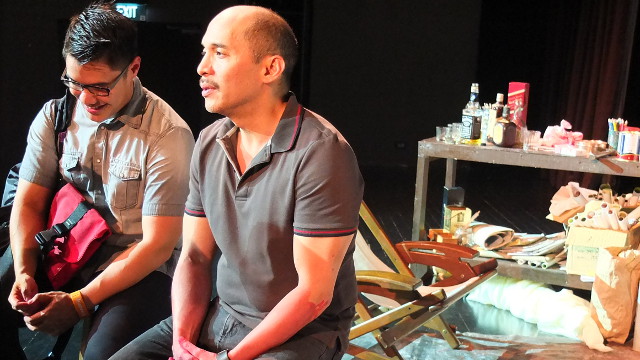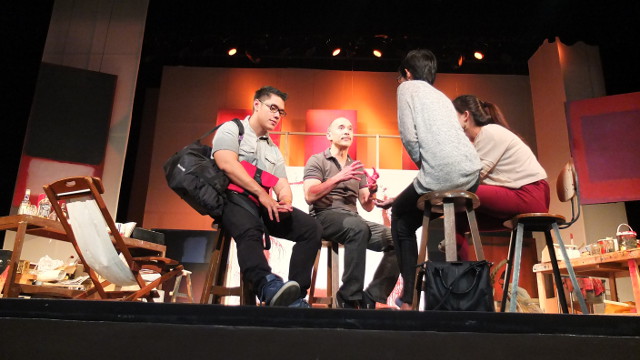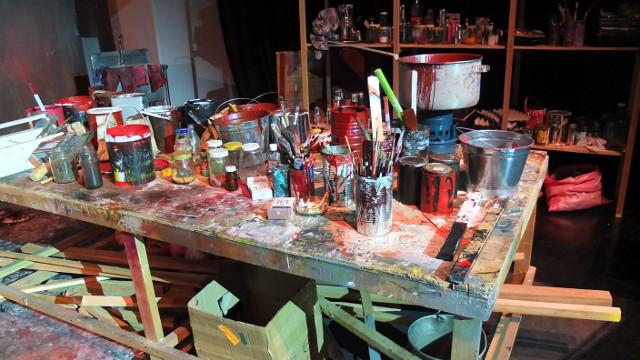SUMMARY
This is AI generated summarization, which may have errors. For context, always refer to the full article.
MANILA, Philippines – The travails of the artist and the triumph of art — these are what David Logan’s Tony Award-winning play “Red” is all about.
Acclaimed theater actor and director Bart Guingona and accomplished thespian Joaquin Valdes brought this theme to the fore with their stunning performances as the abstract painter Mark Rothko and his assistant, Ken.
The two-man play was a back and forth game of power between the two characters with the grouchy, unmoving, and aging Rothko firmly holding on to his reality and the fresh-faced, naïve yet determined Ken insisting that reality is changing.
Their characters had once been played by Alfred Molina (as Rothko) and Eddie Redmayne (as Ken) with the latter winning a Tony for his performance.
Guingona plays Rothko with aplomb, turning his voice into a snarl and a growl, with bent back and stubborn joints, portraying a dog who refuses to learn new tricks.
In contrast, Valdes’s Ken is pleasant, thoughtful, and hopeful despite his tragic back story. Valdes is able to bring out this laddish charm as well as the mature and thought-provoking side of Ken, the Ken that reveals to Rothko his own folly.
Together, the two actors electrify the stage with their chemistry.
A tug-of-war ensues between the two with Guingona’s Rothko bullying Valdes’s Ken until the tables turn and the old generation must give way to the new.
The artist’s soul
The script puts a microscope on the period in Rothko’s life when he was working on what are now known as the Seagram Murals. He had been commissioned by architect Philip Johnson to create these murals for the newly-opened Four Seasons restaurant in the Seagram building in New York City.
In the play, Rothko hires a young painter as an assistant. Ken is the first to point out to him the incongruity of placing his masterpieces in such a commercial setting.
“But it’s a restaurant,” he says, incredulously.
The play confronts a blockade faced by all artists, whether painter, actor, sculptor or poet: the idea of selling out.
“What resonates with me is, what do you do to sell and what do you do for your soul?” says Bart as Rothko.
“It’s always a balancing act. There are people like Rothko who service their soul before anything else. Now that he’s well-known and he’s about to sell out, what does he do? It’s like Kurt Cobain. When he became famous, he freaked out because he thought creating his art in his little cave somewhere was enough. He couldn’t deal with the success.”
But Rothko must face an even bigger problem: irrelevance.
During the period portrayed in the play, Rothko and his “color fields” had become an institution. But as the play unravels — and him along with it — new artists and a new art movement encroach upon him and threaten to push him and his art aside.
No one is more insistent on this than Ken, his assistant, who embraces the new and is perhaps fed up by all of Rothko’s bullying.
Because Guingona’s Rothko is not the nicest boss around.
Throughout most of the play, he explodes in red-hot anger, lets fly dagger-sharp comments and snide remarks and declares his disgust for the non-humans who cannot appreciate his art.
Cerebral candy
To say that “Red” is an achievement for Guingona and Valdes is an understatement because “Red” is not an easy script to pull off.
Logan’s script is more conversation than action, more cerebral than emotional.
The most movement you get is the scene when both actors paint a giant canvas red. Indeed, the dominant language of movement in the play is the language itself, the dialogue.
Throughout the play, Guingona and Valdes unleash cerebral candy.
Particularly memorable is Rothko’s discourse on how paintings are like children, when Guingona transforms from snarling dog to loving father.
You take in a bullet when Guingona’s Rothko blasts that art shouldn’t be “nice” but should shatter your world.
And because this is a play about art, you’ll hear Valdes rhapsodize about the meaning of Rothko’s paintings and the meaning of black and white.
One of the most powerful dialogues in the entire play is when Rothko and Ken shoot each other down with their own meanings for red.
The intellectual, dialogue-driven nature of the play is more a plus than a point against it.
Where theater has become a spectacle for the senses, at times even becoming a circus, “Red” refreshes with its restraint and authenticity.
At its heart is the story of every artist and their struggle to bring their art to the world. Like Rothko’s life and paintings, “Red” will agitate your world the way only great works of art can. – Rappler.com
(‘Red’ will run from March 1 to 2 at 7:30pm at the School of Design and Art at the College of St. Benilde, Manila. Tickets are available at Ticketworld, 891-9999 or 0915-9108098. You can also check www.facebook.com/TheNecessaryTheatre.)
Add a comment
How does this make you feel?



There are no comments yet. Add your comment to start the conversation.